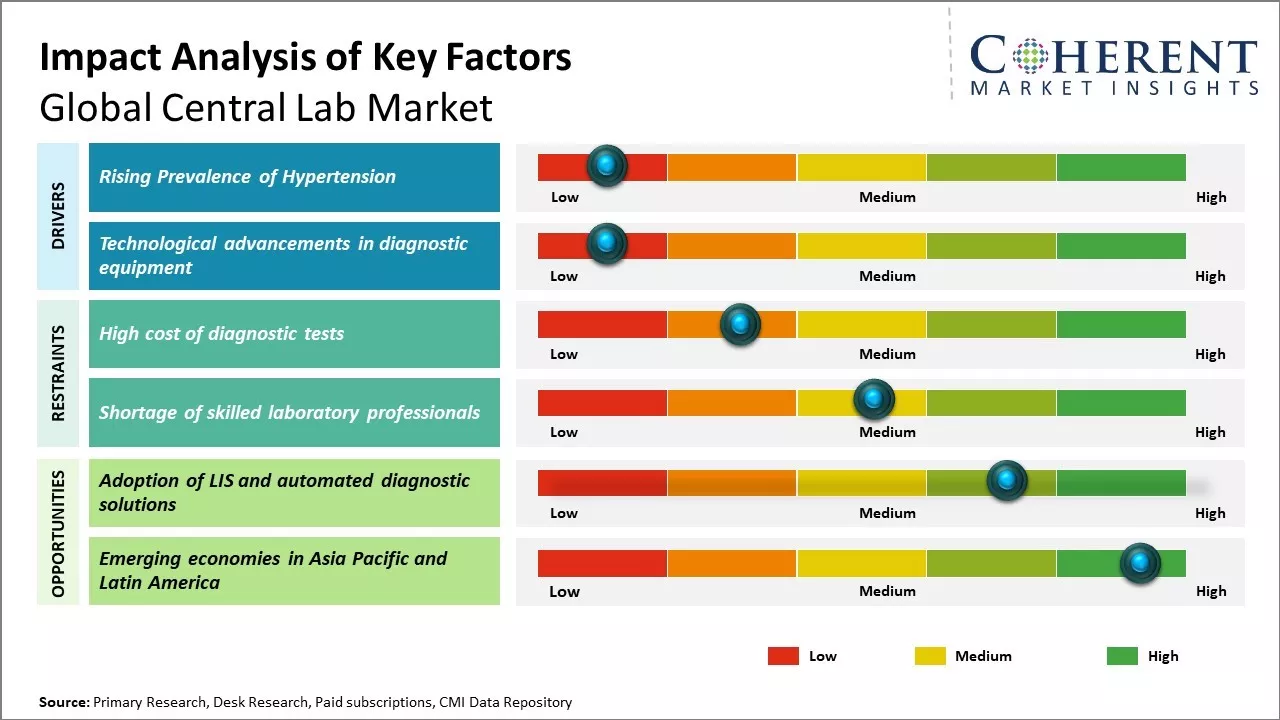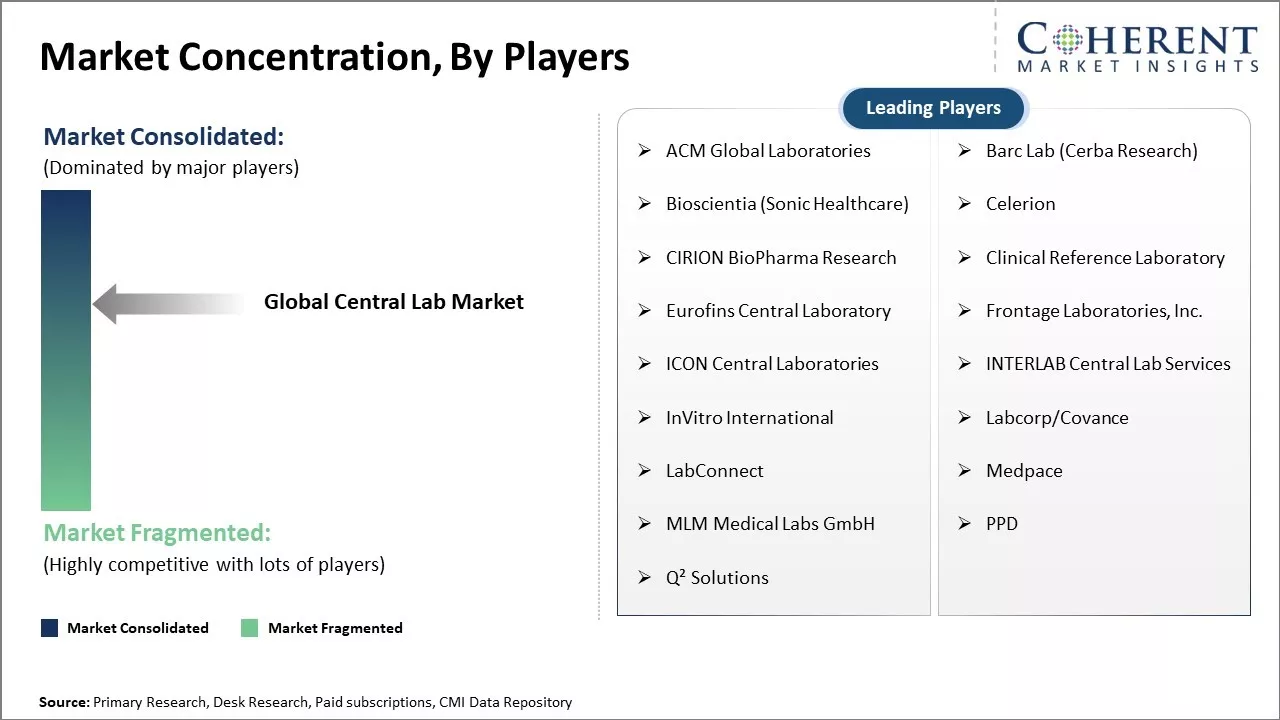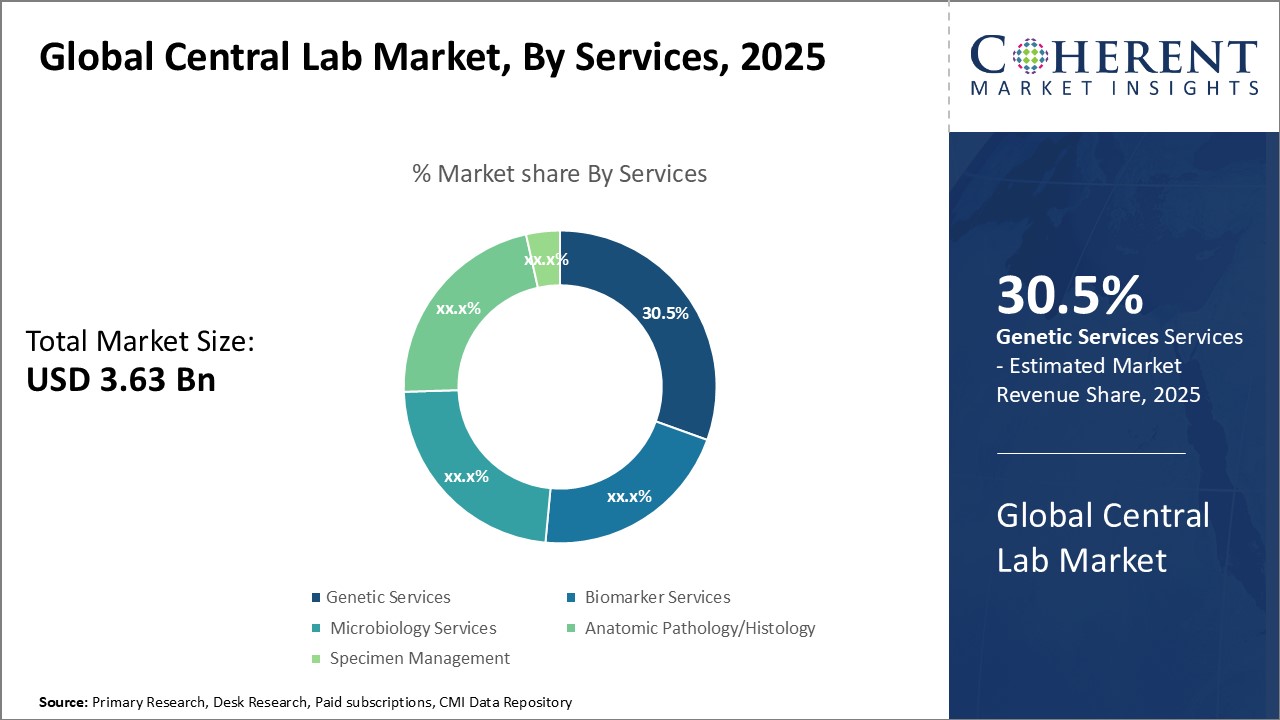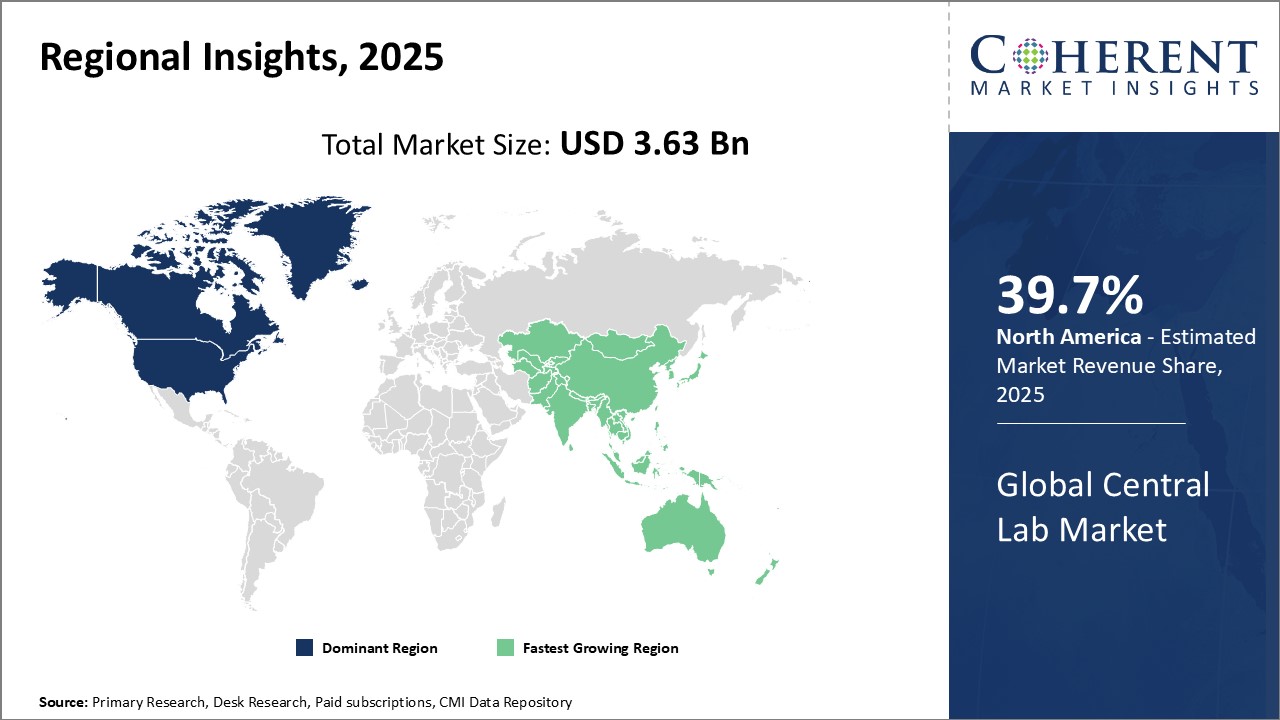Global Central Lab Market Size and Trends
Global central lab market is estimated to be valued at USD 3.63 Bn in 2025 and is expected to reach USD 5.76 Bn by 2032, exhibiting a compound annual growth rate (CAGR) of 6.8% from 2025 to 2032.

Discover market dynamics shaping the industry: Download Free Sample
Global central lab market is expected to witness positive growth over the forecast period due to factors such as increasing volume of diagnostic tests performed, rising prevalence of chronic and infectious diseases, technological advancements in diagnostic testing, and increasing demand for early and accurate disease diagnosis. However, factors such as high installation and maintenance costs of these systems and the requirement of specialized technicians to operate central lab equipment can hamper the market growth during the forecast period.
Rising Demand for Specialized Testing
Global central lab market growth is driven by increasing demand for specialized diagnostic and clinical testing. Healthcare providers are ordering more sophisticated tests than before to aid in diagnosis, develop targeted treatment plans, and monitor patient progress. Continued advancements in medical technology have enabled labs to perform highly complex assays and analysis. Tests like tumor genomic profiling, liquid biopsies, and companion diagnostics provides clinicians more granular insights into diseases at the molecular level. This information helps clinics identify the most effective therapies and personalize care. As new biomarkers and assays are discovered, there has been huge demand for those specialized services from central laboratories. Rare and complex diseases are being diagnosed more frequently as awareness rises. Conditions like cancer, neurological disorders, and genetic abnormalities require intricate testing involving multiple biomarkers, imaging integration, and big data analytics. Such multidisciplinary examination is most effectively handled by centralized labs that have aggregated diverse expertise and scientific capabilities under one roof. Community hospitals and physician offices are referring out those difficult cases more than ever to tap into advanced specialized resources. Furthermore, lifestyle diseases are becoming increasingly common globally due to aging populations and environmental changes. Burgeoning public health issues like diabetes, cardiovascular conditions, and obesity drive heightened disease surveillance needs. For instance, in April 2025, Labcorp exceeded Wall Street's expectations for first-quarter profit, driven by robust demand for specialty tests like cancer and prenatal diagnostics. CEO Adam Schechter highlighted accelerated growth in specialty testing alongside a steady increase in routine tests. With over 2,000 patient service centers in the U.S., Labcorp has benefited from a resurgence in medical procedures and routine check-ups deferred during pandemic restrictions.
Market Concentration and Competitive Landscape

Get actionable strategies to beat competition: Download Free Sample
Technological advancements in diagnostic equipment
Technological advancements in diagnostic equipment can drive the central lab market growth globally. Various advancements such as automation, digitization, artificial intelligence helps labs to improve their efficiency as well as offer advanced quality of services. Use of sophisticated equipment such as immunoassay analyzers, PCR machines, NGS systems have enabled quick diagnosis of wide range of diseases. This has boosted productivity and reduced turnaround time for test reports in central labs. Adoption of laboratory automation solutions by leading central labs has revolutionized their workflow. Automated solutions are assisting in sample sorting, prioritizing, processing, and reducing manual errors. For example, automated storage and retrieval systems are used to store samples and retrieve them in an organized way, thus, reducing chances of misplacement. Advanced LIMS or laboratory information management systems are integrating different automated equipment and streamlining information flow digitally within central labs and with referring hospitals or clinics. This helps labs to scale up their operations as well as offer 24/7 diagnostic services to large population. Artificial intelligence and machine learning technologies are further elevating the quality of diagnostics. AI assistants are aiding in tasks like sample imaging, result interpretations and performing quality checks. Some central labs are deploying AI solutions to flag abnormal diagnostic patterns, detect outliers and interpret complex genomic tests better. As per UNESCO Data, over 30 global labs have already installed AI mammography systems that have increased breast cancer detection rate by 15-20% as compared to humans alone. Such advancements not only improves accuracy but allows predictive, preventive and personalized healthcare.
Key Takeaways from Analyst:
Global central lab market growth is driven by increasing demand for advanced diagnostic tests. Growing prevalence of chronic diseases like cancer and cardiac drives more patients to central labs for quality diagnostic services. Advancing technologies facilitating innovative tests can aid early disease detection. The shift towards value-based care models where labs play a crucial role in preventive disease management can also drive the market growth.
Budgetary constraints of government and private healthcare payers trying to curb diagnostic test costs can hamper the market growth. Price wars among players and lack of reimbursement policies for advanced tests in some regions can also hamper the market growth. Rising need for huge capital investments and long duration required to set up central laboratories can hamper the market growth.
Growing geriatric population vulnerable to multiple ailments can offer market growth opportunities. Asia Pacific region is the fastest growing market due to advancing access to healthcare, and increasing medical tourism from developed nations. Growing collaboration of labs with healthcare providers, hospitals and pharma companies for research and clinical trials can drive the market growth.
Market Challenges: High cost of diagnostic tests
The high cost of diagnostic tests can hamper the central lab market growth. Diagnostic tests performed at centralized labs can be quite expensive for patients as compared to point-of-care tests. This deters many patients from opting for centralized lab tests and instead these either avoid important tests or rely on cheaper alternatives. As per a survey conducted by the National Center for Health Statistics in 2020, around 26% of American adults reported not visiting a doctor in the 2019 due to financial reasons. The survey further found that 11% skipped recommended medical tests or treatments due to their high cost. This clearly shows that cost remains a significant barrier limiting the uptake of diagnostic services especially those offered at centralized laboratories. Further, the rising healthcare costs have also made insurance coverage inadequate for many patients in fully covering expensive diagnostic tests performed at centralized labs. As per a report published by the Commonwealth Fund in 2021, around 29 million American adults reported facing challenges in paying medical bills or were paying off medical debt in 2020. Such financial burden and medical impoverishment discourages individuals from accessing important diagnostic services.
Market Opportunities: Adoption of LIS and automated diagnostic solutions
The adoption of laboratory information systems (LIS) and automated diagnostic solutions can offer growth opportunity for central lab market. LIS solutions allow for streamlined digital management of test requisitions, specimen tracking, result releases and billing. This brings unprecedented efficiency gains through automated workflows. It reduces turnaround time for test results and clerical errors. LIS integrated with automated diagnostic machines also allows for result interpretations by expert systems. This consistency in reporting improves quality of diagnostics. Several countries have launched major public healthcare initiatives that are focusing on incorporating modern technologies to strengthen their health systems. For example, under the National Digital Health Mission of India launched in 2020, digital registries of health records and interoperable statewide health record exchange infrastructure are being set up in India. This creates a huge potential for LIS vendors to provide customized, compliant solutions and for automated diagnostic companies to partner with labs. As more people gain access to healthcare in such developing healthcare systems, there will be huge demand for quality, timely diagnostics. With remote and point-of-care testing gaining popularity due to recent global events, there has been increasing adoption of portable diagnostic devices that can leverage cloud-based LIS systems. This facilitates real-time data collection and monitorability even in resource constrained settings.

Discover high revenue pocket segments and roadmap to it: Download Free Sample
By Services - Genetic Services: Driving Growth Through Personalized Medicine
In terms of services, genetic services segment is estimated to contribute the highest market share of 30 % in 2025, owing to the rapidly growing field of personalized medicine. Genetic testing is helping propel this paradigm shift in healthcare by unlocking a more customized approach to disease screening, diagnosis, and treatment selection based on a person's DNA. As the costs of genetic sequencing increases and understanding of the human genome expands, there will be vast potential for genetic insights. Conditions like cancer, heart disease and neurological disorders can benefit from genetic risk assessments and molecular profiling to refine prognosis and tailor therapeutic strategies.
For pharmaceutical and biotech companies, genetic services provide valuable biomarkers for drug development and opportunities for companion diagnostics. By leveraging genetic factors that influence drug efficacy and safety, these companies can develop drugs and tests together to maximize benefits for subgroups of patients. Academic centers and research institutions also depend heavily on genetic core facilities to support basic research investigating the molecular underpinnings of disease as well as clinical studies evaluating new genomic applications. Clinical laboratories likewise incorporate genetics into expanded test menus to meet the needs of referring physicians and provide answers that improve patient management and outcomes.
By End User - Pharmaceutical Companies: Supporting Drug Development Through Core Lab Services
By end user, pharmaceutical companies segment is estimated to contribute the highest market share of 35 % in 2025. These companies leverage these resources extensively to advance small molecule and biologic drug pipelines.. From early preclinical research through late-stage clinical trials, core labs provide analytical testing that supports drug safety and efficacy evaluations. In drug discovery, cellular and molecular assays help identify potential drug targets. Preclinical toxicology studies rely on histopathology, hematology, clinical chemistry and other tests done by central labs to assess compound safety profiles in animals.
Once in human studies, central labs play an indispensable role by conducting the myriad clinical tests needed to enroll and monitor trial participants. Strict quality control is essential since results directly impact dosing decisions, subject safety and whether studies can progress. Central labs also derive and validate critical biomarkers, which have gained popularity for accelerating drug development. Companion diagnostics informing patient selection depend on robust genetic and genomic testing capabilities.
Regional Insights

Need a Different Region or Segment? Download Free Sample
North America dominates the central lab market with an estimated market share of 39.7% in 2025. With a large population and well-developed healthcare infrastructure, the U.S. accounts for the largest share of the market in the region. Presence of major industry players and strong focus on R&D has ensured technological superiority. The availability of skilled lab technicians and pathologists can also drive the market growth
Samples from the U.S. and Canada are tested in centralized labs located major cities which offer economies of scale. This has enabled labs to drive down costs and offer competitive prices. Strong reimbursement policies through private insurance and public programs boosts testing volumes. Regional trade agreements facilitate smooth movement of samples and supplies within North America.
Asia Pacific region has emerged as the fastest growing market for central labs. Countries like India, China, Japan and South Korea are witnessing rapid economic expansion that improves access to healthcare. Rising incomes have increased demand for advanced diagnostics from an enormous patient base. Furthermore, these nations seek to reduce their dependence on foreign labs by developing domestic testing infrastructure and expertise.
Market Report Scope
Global Central Lab Market Report Coverage
| Report Coverage | Details | ||
|---|---|---|---|
| Base Year: | 2024 | Market Size in 2025: | USD 3.63 Bn |
| Historical Data for: | 2020 To 2024 | Forecast Period: | 2025 To 2032 |
| Forecast Period 2025 to 2032 CAGR: | 6.8% | 2032 Value Projection: | USD 5.76 Bn |
| Geographies covered: |
|
||
| Segments covered: |
|
||
| Companies covered: |
ACM Global Laboratories, Barc Lab (Cerba Research), Bioscientia (Sonic Healthcare), Celerion, CIRION BioPharma Research, Clinical Reference Laboratory, Eurofins Central Laboratory, Frontage Laboratories, Inc., ICON Central Laboratories, INTERLAB Central Lab Services, InVitro International, Labcorp/Covance, LabConnect, Medpace, MLM Medical Labs GmbH, PPD, Q² Solutions |
||
| Growth Drivers: |
|
||
| Restraints & Challenges: |
|
||
Uncover macros and micros vetted on 75+ parameters: Get instant access to report
Global Central Lab Industry News
- In May 2023, Lab Connect, a central clinical research trial laboratory, formed a strategic partnership with Labor Dr. Wisplinghoff to deliver customized and premium central laboratory services across Europe
- In September 2022, MLM Medical Labs GmbH, a GLP-certified, CLIA-, CAP- and ISO15189 accredited central laboratory, expanded its biological sample storage capacity at facilities located in Memphis, TN, and Mönchengladbach, Germany. MLM provides comprehensive sample management services, accommodating storage durations ranging from a few days to over 20 years across all temperature ranges, including ultra-low temperatures down to -80°C and in liquid nitrogen at -196°C.
- In February 2022, Labcorp,/Covance a healthcare company, inaugurated a state-of-the-art diagnostics laboratory in South Bend, U.S., aimed at enhancing service capabilities for physicians and patients locally and nationwide
- In June 2022, KIMS Central Laboratory launched personalized home sample collection services to provide high-quality laboratory investigations. Operated by a NABL-accredited facility with skilled technologists and experienced faculty from the Medical Laboratory Diagnostics Department, the service aims to offer convenient and reliable medical diagnostic solutions directly to individuals' homes.
- In October 2021, Labcorp announced the expansion of its bioanalytical services with a new integrated central laboratory in Singapore. This facility introduces advanced capabilities that enrich the range of bioanalytical services available through Labcorp Drug Development.
*Definition: Central Lab Market is an online marketplace that connects various healthcare facilities and laboratories to accelerate diagnostic testing. It provides a centralized platform for hospitals, clinics, diagnostic centres and labs to easily list their test offerings and available capacities. Medical facilities can browse through profiles of certified labs, compare pricing and turnaround times, and place bulk orders for tests like blood work, urine analysis, microbiology and pathology tests. This streamlines diagnostic testing workflows and eliminates the need to outsource test requirements to multiple labs, saving costs and boosting efficiencies.
Market Segmentation
- Services Insights (Revenue, USD Bn, 2020 - 2032)
- Genetic Services
- Biomarker Services
- Microbiology Services
- Anatomic Pathology/Histology
- Specimen Management & Storage
- Special Chemistry Services
- End User Insights (Revenue, USD Bn, 2020 - 2032)
- Pharmaceutical companies
- Biotechnology Companies
- Academic and Research Institutes
- Clinical Laboratories
- Others
- Regional Insights (Revenue, USD Bn, 2020 - 2032)
- North America
- U.S.
- Canada
- Latin America
- Brazil
- Argentina
- Mexico
- Rest of Latin America
- Europe
- Germany
- U.K.
- Spain
- France
- Italy
- Russia
- Rest of Europe
- Asia Pacific
- China
- India
- Japan
- Australia
- South Korea
- ASEAN
- Rest of Asia Pacific
- Middle East
- GCC Countries
- Israel
- Rest of Middle East
- Africa
- South Africa
- North Africa
- Central Africa
- North America
- Key Players Insights
- ACM Global Laboratories
- Barc Lab (Cerba Research)
- Bioscientia (Sonic Healthcare)
- Celerion
- CIRION BioPharma Research
- Clinical Reference Laboratory
- Eurofins Central Laboratory
- Frontage Laboratories, Inc.
- ICON Central Laboratories
- INTERLAB Central Lab Services
- InVitro International
- Labcorp/Covance
- LabConnect
- Medpace
- MLM Medical Labs GmbH
- PPD
- Q² Solutions
Share
Share
About Author
Nikhilesh Ravindra Patel is a Senior Consultant with over 8 years of consulting experience. He excels in market estimations, market insights, and identifying trends and opportunities. His deep understanding of the market dynamics and ability to pinpoint growth areas make him an invaluable asset in guiding clients toward informed business decisions. He plays a instrumental role in providing market intelligence, business intelligence, and competitive intelligence services through the reports.
Missing comfort of reading report in your local language? Find your preferred language :
Transform your Strategy with Exclusive Trending Reports :
Frequently Asked Questions
EXISTING CLIENTELE
Joining thousands of companies around the world committed to making the Excellent Business Solutions.
View All Our Clients
